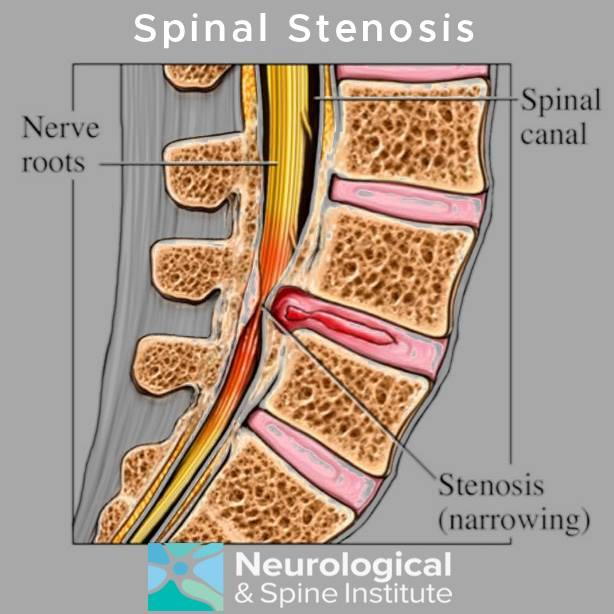What is cervical (neck) spinal stenosis?

Cervical spinal stenosis with myleopathy is diagnosed when degenerative changes in the cervical spine cause spinal cord compression.
The spinal cord is a nerve bundle that runs from the base of the brain to the low back. In a normal spine, there is ample space for the spinal cord in the spinal canal.
In cervical spinal stenosis, however, this space becomes too narrow.
Over time, degenerative changes in the spine can cause the spinal canal to narrow. Having a congenitally narrow spinal canal makes one susceptible to developing cervical spinal stenosis.
Degenerative changes can be caused by one or a combination of conditions, such as osteoarthritis or herniated discs.
In cervical osteoarthritis, cartilage between the facet joints degenerates over time, resulting in friction between the bones.
This friction can lead to the development of osteophytes, or bone spurs, which can encroach upon the nerve roots as they exit the spinal canal through the foraminal opening, or they can encroach centrally on the spinal cord itself.
One or more herniated cervical discs may also contribute to spinal compression if they herniate into the spinal canal.
Herniated discs may further impinge on nerve roots that already have some foraminal compression from osteoarthritis.
Spinal cord compression, or myelopathy, can affect how the spinal cord functions.
The symptoms of cervical spinal cord compression can include a combination of numbness, tingling, weakness, or pain in the arms, hands, and legs.
Symptoms can also include a loss of bladder or bowel control, or problems with balance or coordination, such as a shuffling gait or tripping easily when walking.
Cervical spinal stenosis with myleopathy can be permanently disabling if it is allowed to progress too far. It can be treated with a cervical decompression surgery.
https://www.spine-health.com/video/cervical-spinal-stenosis

Cervical spinal stenosis with myleopathy is diagnosed when degenerative changes in the cervical spine cause spinal cord compression.
The spinal cord is a nerve bundle that runs from the base of the brain to the low back. In a normal spine, there is ample space for the spinal cord in the spinal canal.
In cervical spinal stenosis, however, this space becomes too narrow.
Over time, degenerative changes in the spine can cause the spinal canal to narrow. Having a congenitally narrow spinal canal makes one susceptible to developing cervical spinal stenosis.
Degenerative changes can be caused by one or a combination of conditions, such as osteoarthritis or herniated discs.
In cervical osteoarthritis, cartilage between the facet joints degenerates over time, resulting in friction between the bones.
This friction can lead to the development of osteophytes, or bone spurs, which can encroach upon the nerve roots as they exit the spinal canal through the foraminal opening, or they can encroach centrally on the spinal cord itself.
One or more herniated cervical discs may also contribute to spinal compression if they herniate into the spinal canal.
Herniated discs may further impinge on nerve roots that already have some foraminal compression from osteoarthritis.
Spinal cord compression, or myelopathy, can affect how the spinal cord functions.
The symptoms of cervical spinal cord compression can include a combination of numbness, tingling, weakness, or pain in the arms, hands, and legs.
Symptoms can also include a loss of bladder or bowel control, or problems with balance or coordination, such as a shuffling gait or tripping easily when walking.
Cervical spinal stenosis with myleopathy can be permanently disabling if it is allowed to progress too far. It can be treated with a cervical decompression surgery.
https://www.spine-health.com/video/cervical-spinal-stenosis
HealthOU Blog
Alumni Spotlight – Dr. Stacy-Ann Smith D.C.
Visit our Office
705 Park Ave
Lake Park, FL 33403
